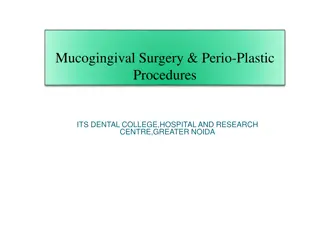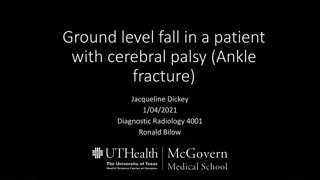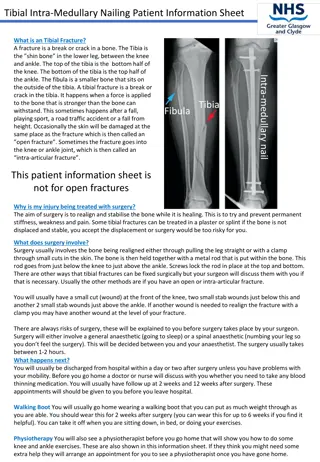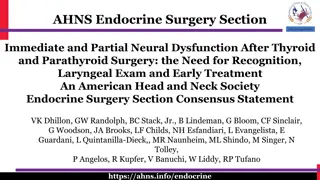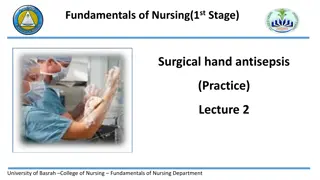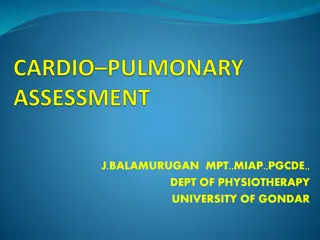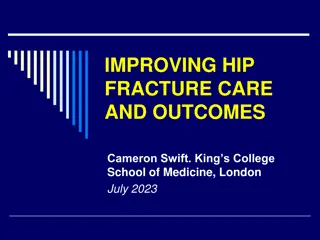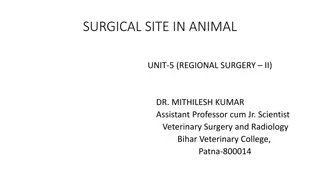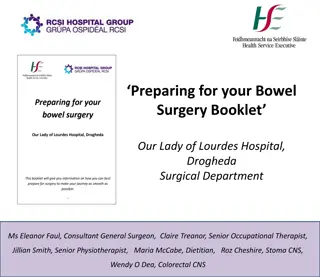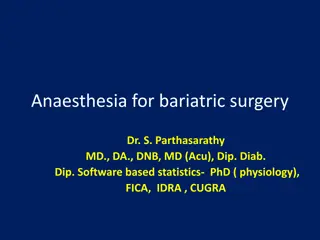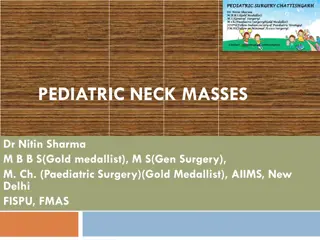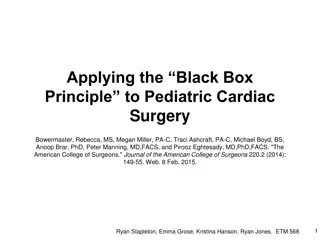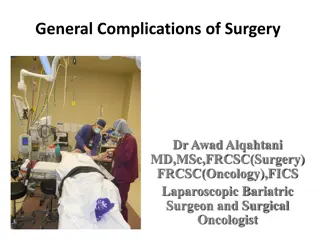Impact of Surgical Treatment on Physiotherapy Outcome in Femoral Neck Fracture Surgery
Early mobilisation post-hip fracture surgery plays a crucial role in patient outcomes. A study at Our Lady of Lourdes Hospital, Drogheda, compared the rehabilitation progress of patients based on the type of surgery received: arthroplasty or internal fixation. Results showed that arthroplasty patients had lower functional ability initially but showed significant improvement at discharge, while more internal fixation patients were discharged directly home. Both treatments led to functional gains, highlighting the importance of tailored physiotherapy interventions post-surgery.
Download Presentation

Please find below an Image/Link to download the presentation.
The content on the website is provided AS IS for your information and personal use only. It may not be sold, licensed, or shared on other websites without obtaining consent from the author. Download presentation by click this link. If you encounter any issues during the download, it is possible that the publisher has removed the file from their server.
E N D
Presentation Transcript
Mobility Following Femoral Neck Fracture Surgery: Does Surgical Treatment Affect Physiotherapy Outcome? Sarah McShane, Elaine McCabe, Helen French, Eil s Hand, Deirdre Gilsenan, Orlagh Hynes, Abishekar Bisseru & Aaron Glynn Orthopaedic Services Our Lady of Lourdes Hospital, Drogheda, Co.Louth
Introduction/Background: Early mobilisation post hip fracture surgery is associated with direct discharge home (1). The surgery type available to hip fracture patients is dependant on the fracture type. Arthroplasties are generally employed for displaced neck of femur (NOF) fractures while internal fixation (IF) is commonly used for un-displaced and pertrochanteric fracture patterns (3,4). The physiotherapy department in Our Lady of Lourdes Hospital (OLOLH) Drogheda, provides a seven-day orthopaedic service and aims to ensure that all patients post hip surgery are assessed and mobilised (where possible) within 24 hours of surgery. In 2019 99% of hip fracture patients in OLOLH Drogheda were reviewed by a physiotherapist on the day of or the day after their surgery (2). Their physiotherapy management continued for the duration of their inpatient stay. To establish patient progression with physiotherapy intervention, in the acute post-operative stage, standardised outcome measures are routinely used. The Timed Up & Go (TUG), The Cumulative Ambulatory Score (CAS) and The New Mobility Score (NMS) are the outcome measures of choice. Aims/Objectives: The aim of this study was to establish if there were differences in rates of patient progression, depending on the surgery type received, and ultimately to highlight if one surgical intervention group had a greater rehabilitation need vs. the other at the time of discharge from the acute setting, when treated with the same physiotherapy intervention
Methods: A prospective database was used to audit outcomes patients admitted to the orthopaedic ward in OLOLH, from October 2019 October 2020. Complete data was collected on 134 hip fracture patients. The NMS was calculated based on the patients pre-fracture function, and acted as a good predictor of early mobility levels post-operatively. The TUG was performed as soon as patients were able to complete same post- surgery and again at discharge. Due to the small number of patients with inter-trochanteric and sub-trochanteric fractures, to enable comparison between different surgery types, only those with NOF fracture (n=89) were retained in the analysis. For comparative purposes, the Hemi- arthroplasties and THR were grouped together (arthroplasty) and the DHS and nails were grouped together (IF). Descriptive statistics (median and IQR) for continuous outcomes, and number (%) for categorical outcomes, were used to compare initial and discharge outcomes for both arthroplasty and IF groups. All statistical analysis were conducted in STATA (v16). for hip fracture the time of Table 1: Patient Characteristics
Results: Conclusions: Hip fracture patients treated with arthroplasty had lower functional ability on day one post-operatively compared to the IF group. Patients treated with arthroplasty showed the greatest overall improvement in function and mobility at the time of discharge. A greater proportion of the IF group were discharged directly home (55% vs 38%) and able to receive any ongoing rehabilitation as an outpatient, while the majority of the arthroplasty group required further inpatient rehabilitation. This audit highlighted that both hip fracture treatment modalities allowed gains in functional outcomes, but >90% of patients, based of TUG scores, remained at risk of future falls, irrespective of surgical intervention, at the time of discharge, thus indicating the need for further physiotherapy input. 1.. Ferris H, Brent L, Sorensen J, Ahern E, Coughlan T. Discharge destination after hip fracture: findings from the Irish hip fracture database. Eur Geriatr Med. 2021 Aug 22 2.Irish Hip Fracture Database (2020) Irish Hip Fracture Database Report 2019, Stay safe and active at home., Ireland: Irish Hip Fracture Database. 3. NICE (2017) Hip Fracture Management, UK: NICE Guidelines. 4. Conn KS, Parker MJ (2004) 'Un-displaced intracapsular hip fractures: results of internal fixation in 375 patients. ', Clinical Orthopaedics and Related Research, (421), pp. 249-254. .






